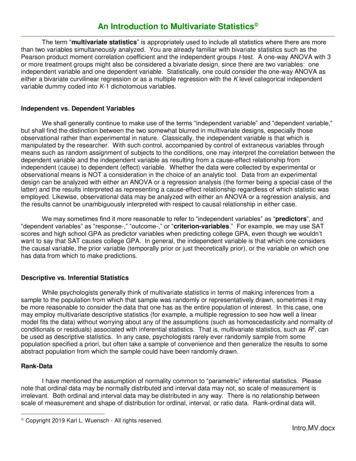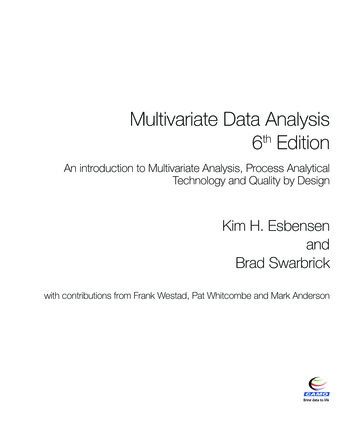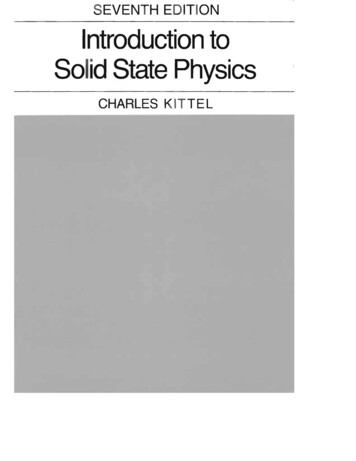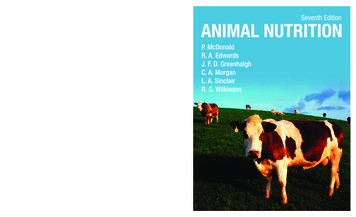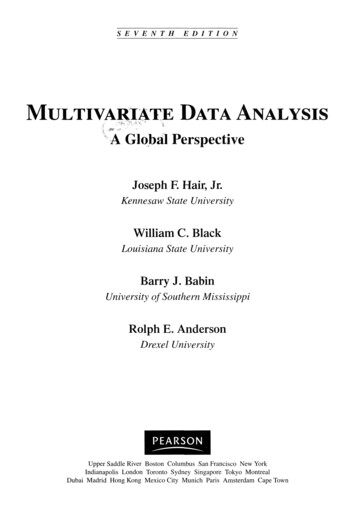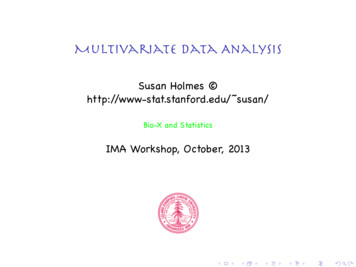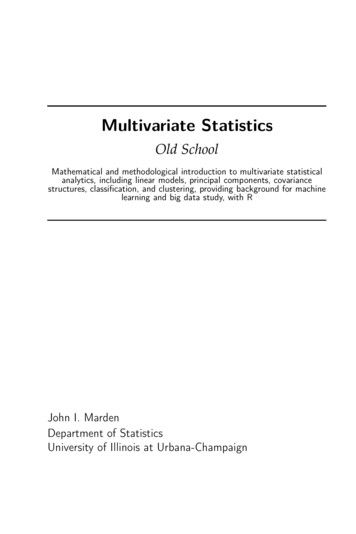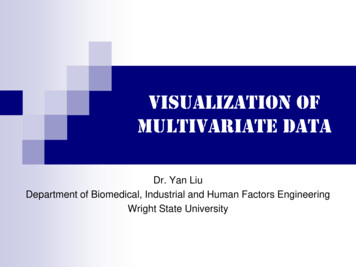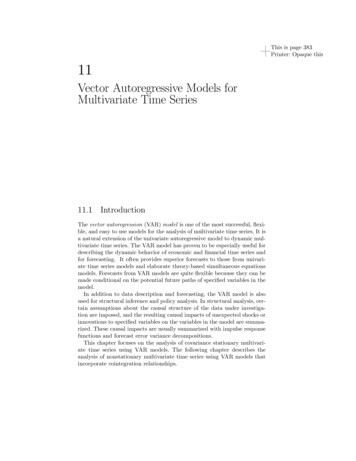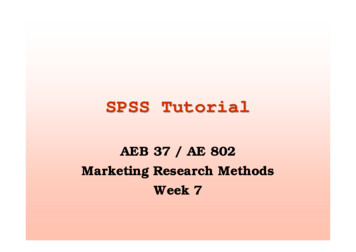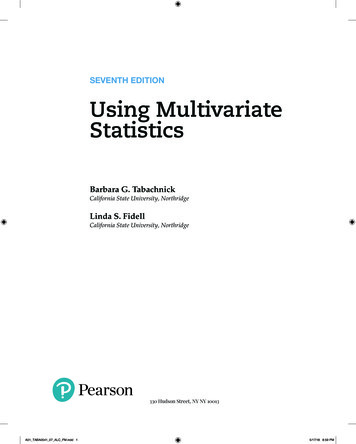
Transcription
SEVENTH EDITIONUsing MultivariateStatisticsBarbara G. TabachnickCalifornia State University, NorthridgeLinda S. FidellCalifornia State University, Northridge330 Hudson Street, NY NY 10013A01 TABA0541 07 ALC FM.indd 15/17/18 8:59 PM
Portfolio Manager: Tanimaa MehraContent Producer: Kani KapoorPortfolio Manager Assistant: Anna AustinProduct Marketer: Jessica QuazzaArt/Designer: Integra Software Services Pvt. Ltd.Fu ll-Service Project Manager: Integra SoftwareServices Pvt. Ltd.Co mpositor: Integra SoftwareServices Pvt. Ltd.Printer/Binder: LSC Communications, Inc.Cover Printer: Phoenix Color/HagerstownCover Design: Lumina Datamatics, Inc.Cover Art: ShutterstockAcknowledgments of third party content appear on pages within the text, which constitutes an extension of thiscopyright page.Copyright 2019, 2013, 2007 by Pearson Education, Inc. or its affiliates. All Rights Reserved. Printed in theUnited States of America. This publication is protected by copyright, and permission should be obtained fromthe publisher prior to any prohibited reproduction, storage in a retrieval system, or transmission in any form orby any means, electronic, mechanical, photocopying, recording, or otherwise. For information regarding permissions, request forms and the appropriate contacts within the Pearson Education Global Rights & Permissionsdepartment, please visit www.pearsoned.com/permissions/.PEARSON and ALWAYS LEARNING are exclusive trademarks owned by Pearson Education, Inc. or its affiliates, in the U.S., and/or other countries.Unless otherwise indicated herein, any third-party trademarks that may appear in this work are the property oftheir respective owners and any references to third-party trademarks, logos or other trade dress are for demonstrative or descriptive purposes only. Such references are not intended to imply any sponsorship, endorsement,authorization, or promotion of Pearson’s products by the owners of such marks, or any relationship between theowner and Pearson Education, Inc. or its affiliates, authors, licensees or distributors.Many of the designations by manufacturers and seller to distinguish their products are claimed as trademarks.Where those designations appear in this book, and the publisher was aware of a trademark claim, the designations have been printed in initial caps or all caps.Library of Congress Cataloging-in-Publication DataNames: Tabachnick, Barbara G., author. Fidell, Linda S., author.Title: Using multivariate statistics/Barbara G. Tabachnick, California State University, Northridge,Linda S. Fidell, California State University, Northridge.Description: Seventh edition. Boston: Pearson, [2019] Chapter 14,by Jodie B. Ullman.Identifiers: LCCN 2017040173 ISBN 9780134790541 ISBN 0134790545Subjects: LCSH: Multivariate analysis. Statistics.Classification: LCC QA278 .T3 2019 DDC 519.5/35—dc23LC record available at https://lccn.loc.gov/2017040173118Books a la CarteISBN-10:0-13-479054-5ISBN-13: 978-0-13-479054-1A01 TABA0541 07 ALC FM.indd 25/17/18 8:59 PM
ContentsPreface 12.1.3 Prediction of Group Membership xivIntroduction 11.1 Multivariate Statistics: Why? 11.1.1 The Domain of Multivariate Statistics:Numbers of IVs and DVs 21.1.2 Experimental and NonexperimentalResearch 21.1.3 Computers and Multivariate Statistics 31.1.4 Garbage In, Roses Out? 42.1.4 Structure 1.2 Some Useful Definitions 51.2.1 Continuous, Discrete, and DichotomousData 51.2.2 Samples and Populations 61.2.3 Descriptive and Inferential Statistics 71.2.4 Orthogonality: Standard and SequentialAnalyses 71.3 Linear Combinations of Variables 101.5 Statistical Power 101.6 Data Appropriate for Multivariate Statistics 111.6.1 The Data Matrix 111.6.2 The Correlation Matrix 121.6.3 The Variance–Covariance Matrix 121.6.4 The Sum-of-Squares and Cross-ProductsMatrix 131.6.5 Residuals 141.7 Organization of the Book 142A Guide to Statistical Techniques:Using the Book 152.1 Research Questions and Associated Techniques 152.1.1 Degree of Relationship Among Variables ate r 16Multiple R 16Sequential R 16Canonical R 16Multiway Frequency Analysis 17Multilevel Modeling 172.1.2 Significance of Group Differences 2.1.4.1 Principal Components 2.1.4.2 Factor Analysis 2.1.4.3 Structural Equation Modeling 2.1.5 Time Course of Events 2.1.5.1 Survival/Failure Analysis 2.1.5.2 Time-Series Analysis 2.22.32.42.591.4 Number and Nature of Variables to Include 172.1.2.1 One-Way ANOVA and t Test 172.1.2.2 One-Way ANCOVA 172.1.2.3 Factorial ANOVA 182.1.2.4 Factorial ANCOVA 182.1.2.5 Hotelling’s T 2 182.1.2.6 One-Way MANOVA 182.1.2.7 One-Way MANCOVA 192.1.2.8 Factorial MANOVA 192.1.2.9 Factorial MANCOVA 192.1.2.10 Profile Analysis of Repeated Measures 19202.1.3.1 One-Way Discriminant Analysis 202.1.3.2 Sequential One-Way DiscriminantAnalysis 202.1.3.3 Multiway Frequency Analysis(Logit) 212.1.3.4 Logistic Regression 212.1.3.5 Sequential Logistic Regression 212.1.3.6 Factorial Discriminant Analysis 212.1.3.7 Sequential Factorial DiscriminantAnalysis 22322222222222323Some Further Comparisons 23A Decision Tree 24Technique Chapters 27Preliminary Check of the Data 28Review of Univariate andBivariate Statistics 293.1 Hypothesis Testing 293.1.1 One-Sample z Test as Prototype 303.1.2 Power 323.1.3 Extensions of the Model 323.1.4 Controversy Surrounding SignificanceTesting 333.2 Analysis of Variance 3.2.1 One-Way Between-Subjects ANOVA 3.2.2 Factorial Between-Subjects ANOVA 3.2.3 Within-Subjects ANOVA 3.2.4 Mixed Between-Within-Subjects ANOVA 3.2.5 Design Complexity 3.2.5.13.2.5.23.2.5.33.2.5.4Nesting Latin-Square Designs Unequal n and Nonorthogonality Fixed and Random Effects 3.2.6 Specific Comparisons 33343638404141424243433.2.6.1 Weighting Coefficients forComparisons 433.2.6.2 Orthogonality of WeightingCoefficients 443.2.6.3 Obtained F for Comparisons 443.2.6.4 Critical F for Planned Comparisons 453.2.6.5 Critical F for Post Hoc Comparisons 453.3 Parameter Estimation 463.4 Effect Size 47iiiA01 TABA0541 07 ALC FM.indd 35/17/18 8:59 PM
iv Contents3.5 Bivariate Statistics: Correlation and Regression 483.5.1 Correlation 483.5.2 Regression 493.6 Chi-Square Analysis 4Cleaning Up Your Act: ScreeningData Prior to Analysis 4.1 Important Issues in Data Screening 4.1.1 Accuracy of Data File 4.1.2 Honest Correlations 4.1.2.1 Inflated Correlation 4.1.2.2 Deflated Correlation 4.1.3 Missing Data 50525353535353544.1.3.1 Deleting Cases or Variables 574.1.3.2 Estimating Missing Data 574.1.3.3 Using a Missing Data CorrelationMatrix 614.1.3.4 Treating Missing Data as Data 614.1.3.5 Repeating Analyses with and withoutMissing Data 614.1.3.6 Choosing Among Methods forDealing with Missing Data 624.1.4 Outliers 4.1.4.1 Detecting Univariate andMultivariate Outliers 4.1.4.2 Describing Outliers 4.1.4.3 Reducing the Influenceof Outliers 4.1.4.4 Outliers in a Solution 636666676872734.1.6 Common Data Transformations 754.1.7 Multicollinearity and Singularity 764.1.8 A Checklist and Some PracticalRecommendations 794.2 Complete Examples of Data Screening 4.2.1 Screening Ungrouped Data 4.2.1.1 Accuracy of Input, Missing Data,Distributions, and Univariate Outliers 4.2.1.2 Linearity and Homoscedasticity 4.2.1.3 Transformation 4.2.1.4 Detecting Multivariate Outliers 4.2.1.5 Variables Causing Cases to Be Outliers 4.2.1.6 Multicollinearity 4.2.2 Screening Grouped Data 4.2.2.1 Accuracy of Input, Missing Data,Distributions, Homogeneity of Variance,and Univariate Outliers 4.2.2.2 Linearity 4.2.2.3 Multivariate Outliers 4.2.2.4 Variables Causing Cases to Be Outliers 4.2.2.5 Multicollinearity A01 TABA0541 07 ALC FM.indd 4Multiple Regression 5.1 General Purpose and Description 7980818484848688991011011021021021021025.3 Limitations to Regression Analyses 5.3.1 Theoretical Issues 5.3.2 Practical Issues 1031031041031035.3.2.1 Ratio of Cases to IVs 1055.3.2.2 Absence of Outliers Amongthe IVs and on the DV 1055.3.2.3 Absence of Multicollinearity andSingularity 1065.3.2.4 Normality, Linearity, andHomoscedasticity of Residuals 1065.3.2.5 Independence of Errors 1085.3.2.6 Absence of Outliers in the Solution 1095.4 Fundamental Equations for MultipleRegression 1095.4.1 General Linear Equations 1105.4.2 Matrix Equations 1115.4.3 Computer Analyses of Small-SampleExample 1135.5 Major Types of Multiple Regression 1155.5.1 Standard Multiple Regression 1155.5.2 Sequential Multiple Regression 1165.5.3 Statistical (Stepwise) Regression 1175.5.4 Choosing Among RegressionStrategies 1215.6 Some Important Issues 5.6.1 Importance of IVs 5.6.1.1 Standard Multiple Regression 5.6.1.2 Sequential or Statistical Regression 5.6.1.3 Commonality Analysis 5.6.1.4 Relative Importance Analysis 5.6.2 Statistical Inference .2 Kinds of Research Questions 5.2.1 Degree of Relationship 5.2.2 Importance of IVs 5.2.3 Adding IVs 5.2.4 Changing IVs 5.2.5 Contingencies Among IVs 5.2.6 Comparing Sets of IVs 5.2.7 Predicting DV Scoresfor Members of a New Sample 5.2.8 Parameter Estimates 624.1.5 Normality, Linearity, andHomoscedasticity 674.1.5.1 Normality 4.1.5.2 Linearity 4.1.5.3 Homoscedasticity, Homogeneityof Variance, and Homogeneity ofVariance–Covariance Matrices 5121121122123123125128Test for Multiple R 128Test of Regression Components 129Test of Added Subset of IVs 130Confidence Limits 130Comparing Two Sets of Predictors 131Adjustment of R2 132Suppressor Variables 133Regression Approach to ANOVA 134Centering When Interactionsand Powers of IVs Are Included 1355.6.7 Mediation in Causal Sequence 1375.6.35.6.45.6.55.6.65/17/18 8:59 PM
Contents5.7 Complete Examples of Regression Analysis 5.7.1 Evaluation of Assumptions 5.7.1.1 Ratio of Cases to IVs 5.7.1.2 Normality, Linearity,Homoscedasticity, andIndependence of Residuals 5.7.1.3 Outliers 5.7.1.4 Multicollinearity and Singularity 5.7.2 Standard Multiple Regression 5.7.3 Sequential Regression 5.7.4 Example of Standard MultipleRegression with Missing ValuesMultiply Imputed 5.8 Comparison of Programs 5.8.1 IBM SPSS Package 5.8.2 SAS System 5.8.3 SYSTAT System 6Analysis of Covariance 6.1 General Purpose and Description 1381391396.3.2.1 Unequal Sample Sizes, MissingData, and Ratio of Cases to IVs 6.3.2.2 Absence of Outliers 6.3.2.3 Absence of Multicollinearityand Singularity 6.3.2.4 Normality of Sampling Distributions 6.3.2.5 Homogeneity of Variance 6.3.2.6 Linearity 6.3.2.7 Homogeneity of Regression 6.3.2.8 Reliability of Covariates 6.5.4.1 Within-Subjects and MixedWithin-Between Designs 6.5.4.2 Unequal Sample Sizes A01 TABA0541 07 ALC FM.indd 56.6.1.1 Unequal n and Missing Data 6.6.1.2 Normality 6.6.1.3 Linearity 6.6.1.4 Outliers 6.6.1.5 Multicollinearity and Singularity 6.6.1.6 Homogeneity of Variance 6.6.1.7 Homogeneity of Regression 6.6.1.8 Reliability of Covariates 1541621631651666.6.2 Analysis of Covariance 6.6.2.1 Main Analysis 6.6.2.2 Evaluation of Covariates 6.6.2.3 Homogeneity of Regression Run 1676.7 Comparison of Programs 6.7.1 IBM SPSS Package 6.7.2 SAS System 6.7.3 SYSTAT System 11811821851871876.6 Complete Example of Analysis of Covariance 1896.6.1 Evaluation of Assumptions 1891441506.4 Fundamental Equations for Analysisof Covariance 1746.4.1 Sums of Squares and Cross-Products 1756.4.2 Significance Test and Effect Size 1776.4.3 Computer Analyses of Small-SampleExample 1786.5 Some Important Issues 6.5.1 Choosing Covariates 6.5.2 Evaluation of Covariates 6.5.3 Test for Homogeneity of Regression 6.5.4 Design Complexity 6.5.5 Alternatives to ANCOVA 1391421446.2 Kinds of Research Questions 1706.2.1 Main Effects of IVs 1706.2.2 Interactions Among IVs 1706.2.3 Specific Comparisons and TrendAnalysis 1706.2.4 Effects of Covariates 1706.2.5 Effect Size 1716.2.6 Parameter Estimates 1716.3 Limitations to Analysis of Covariance 6.3.1 Theoretical Issues 6.3.2 Practical Issues 6.5.4.3 Specific Comparisons andTrend Analysis 6.5.4.4 Effect Size v7Multivariate Analysis ofVariance and Covariance 37.1 General Purpose and Description 2037.2 Kinds of Research Questions 7.2.1 Main Effects of IVs 7.2.2 Interactions Among IVs 7.2.3 Importance of DVs 7.2.4 Parameter Estimates 7.2.5 Specific Comparisonsand Trend Analysis 7.2.6 Effect Size 7.2.7 Effects of Covariates 7.2.8 Repeated-Measures Analysisof Variance 2062062072072077.3 Limitations to Multivariate Analysisof Variance and Covariance 7.3.1 Theoretical Issues 7.3.2 Practical Issues 7.3.2.1 Unequal Sample Sizes,Missing Data, and Power 7.3.2.2 Multivariate Normality 7.3.2.3 Absence of Outliers 7.3.2.4 Homogeneity of Variance–Covariance Matrices 7.3.2.5 Linearity 7.3.2.6 Homogeneity of Regression 7.3.2.7 Reliability of Covariates 7.3.2.8 Absence of Multicollinearityand Singularity 7.4 Fundamental Equations for MultivariateAnalysis of Variance and Covariance 7.4.1 Multivariate Analysis of Variance 25/17/18 8:59 PM
vi Contents7.4.2 Computer Analysesof Small-Sample Example 7.4.3 Multivariate Analysisof Covariance 7.5 Some Important Issues 7.5.1 MANOVA Versus ANOVAs 7.5.2 Criteria for Statistical Inference 7.5.3 Assessing DVs 8.3.2.2 Multivariate Normality 8.3.2.3 Absence of Outliers 8.3.2.4 Homogeneity ofVariance–Covariance Matrices 8.3.2.5 Linearity 8.3.2.6 Absence of Multicollinearityand Singularity 2182212232232232248.5 Some Important Issues 8.5.1 Univariate Versus MultivariateApproach to Repeated Measures 8.5.2 Contrasts in Profile Analysis 7.5.4 Specific Comparisons and TrendAnalysis 2277.5.5 Design Complexity 2287.6 Complete Examples of MultivariateAnalysis of Variance and Covariance 7.6.1 Evaluation of Assumptions 7.6.1.1 Unequal Sample Sizesand Missing Data 7.6.1.2 Multivariate Normality 7.6.1.3 Linearity 7.6.1.4 Outliers 7.6.1.5 Homogeneity of Variance–Covariance Matrices 7.6.1.6 Homogeneity of Regression 7.6.1.7 Reliability of Covariates 7.6.1.8 Multicollinearity and Si
Data Prior to Analysis 52 4.1 Important Issues in Data Screening 53 4.1.1 Accuracy of Data File 53 4.1.2 Honest Correlations 53 4.1.2.1 Inflated Correlation 53 4.1.2.2 Deflated Correlation 53 4.1.3 Missing Data 54 4.1.3.1 Deleting Cases or Variables 57 4.1.3.2 Estimating Missing Data 57 4.1.3.3 Using a Missing Data Correlation Matrix 61File Size: 558KBPage Count: 14


